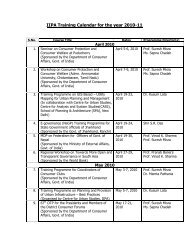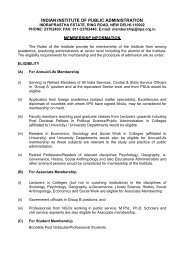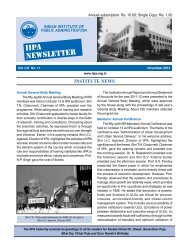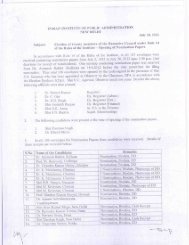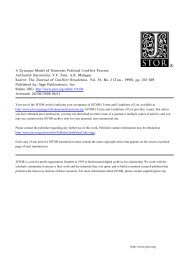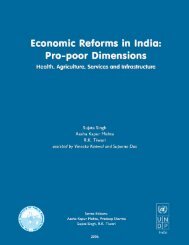India's Telecom Reform - Indian Institute of Public Administration
India's Telecom Reform - Indian Institute of Public Administration
India's Telecom Reform - Indian Institute of Public Administration
You also want an ePaper? Increase the reach of your titles
YUMPU automatically turns print PDFs into web optimized ePapers that Google loves.
India’s <strong>Telecom</strong> <strong>Reform</strong>: A Chronological Account<br />
ture. Time will tell if the new approach will be followed<br />
and if it can deliver to the rural poor the benefits that the<br />
urban poor have begun to enjoy, thanks to policy reforms<br />
undertaken in the sector.<br />
There is also a renewed effort from players other than<br />
telecommunications operators in rural telecommunications<br />
space. A growing list <strong>of</strong> technology innovators<br />
and entrepreneurs has been active in testing<br />
new ICT services and business models to serve rural<br />
populations. Many <strong>of</strong> these efforts now form a part<br />
<strong>of</strong> Mission 2007, a vision <strong>of</strong> Pr<strong>of</strong>essor M.S.<br />
Swaminathan, to establish knowledge centres in all<br />
villages by August 2007. Some <strong>of</strong> these efforts are<br />
highlighted in the Appendix by Ch. Sambasiva Rao,<br />
attached to this report. Many <strong>of</strong> these initiatives<br />
would require policy and regulatory support, especially<br />
when the models are sought to be scaled up<br />
from their “pilot phases”. It will be interesting to see<br />
the degree to which such efforts succeed.<br />
The <strong>Telecom</strong> Policy Evolution: A<br />
Background<br />
India’s telecommunications reform programme has been<br />
underway since the late 1980s when the government’s<br />
monopoly in manufacturing telecom equipment was discontinued.<br />
However, the more substantive reform was the<br />
progressive deregulation <strong>of</strong> the services sector, from a situation<br />
where the Government <strong>of</strong> India’s Department <strong>of</strong><br />
<strong>Telecom</strong>munications (DoT) was the policy maker, operator<br />
and regulator, all in one. DoT’s success in this role was<br />
mixed. The network grew significantly, but in comparison<br />
to most countries, India remained far behind with long<br />
waiting lists and poor service quality.<br />
Early attempts to reform the services were modest, with<br />
the opening <strong>of</strong> some value-added services such as electronic<br />
mail, audio-text, etc., to private sector players. This<br />
was followed by an attempt to allow private sector players<br />
to enter the mobile service sector. This exercise, and<br />
the litigation that ensued, reflected the first signs <strong>of</strong> the<br />
challenge that lay in ad hoc changes to telecom policy without<br />
a clear regulatory framework.<br />
In 1994, the Government <strong>of</strong> India announced the National<br />
<strong>Telecom</strong> Policy (NTP), which defined certain important<br />
objectives, including availability <strong>of</strong> telephones on<br />
demand, the provision <strong>of</strong> world-class services at reasonable<br />
prices, ensuring India’s emergence as a major manufacturing/export<br />
base for telecom equipment and universal<br />
availability <strong>of</strong> basic telecom services to all villages. It<br />
also announced a series <strong>of</strong> specific targets to be achieved<br />
by 1997. Against the NTP 1994 target <strong>of</strong> the provision <strong>of</strong><br />
one PCO per 500 urban population and coverage <strong>of</strong> all<br />
600,000 villages, DoT has achieved an urban PCO penetration<br />
<strong>of</strong> one PCO per 522 persons, and has been able<br />
to provide telephone coverage to only 310,000 villages. As<br />
regards provision <strong>of</strong> total telephone lines in the country,<br />
DoT has provided 8.73 million telephone lines against the<br />
Eighth Plan target <strong>of</strong> 7.5 million lines.<br />
NTP 1994 also recognised that the required resources for<br />
achieving these targets would not be available only from<br />
government sources and concluded that private investment<br />
and private sector involvement were required to bridge<br />
the resource gap. The government invited private sector<br />
participation in a phased manner from the early nineties,<br />
initially for value added services such as paging services<br />
and Cellular Mobile Telephone Services (CMTS) and thereafter<br />
for Fixed Telephone Services (FTS). After a competitive<br />
bidding process, licenses were awarded to eight<br />
CMTS operators in the four metros, 14 CMTS operators<br />
in 18 state Circles, six BTS operators in six state Circles<br />
and paging operators in 27 cities and 18 state Circles. VSAT<br />
services were liberalised for providing data services to closed<br />
user groups. Licenses were issued to 14 operators in the<br />
private sector, out <strong>of</strong> which only nine licensees are operational.<br />
The government has recently announced a policy<br />
for Internet Service Provision (ISP) by private operators<br />
and has commenced licensing <strong>of</strong> the same. The government<br />
has also announced the opening up <strong>of</strong> Global Mobile<br />
Personal Communications by Satellite (GMPCS) and<br />
issued one provisional license. The issue <strong>of</strong> licenses to other<br />
prospective GMPCS operators is under consideration.<br />
2




